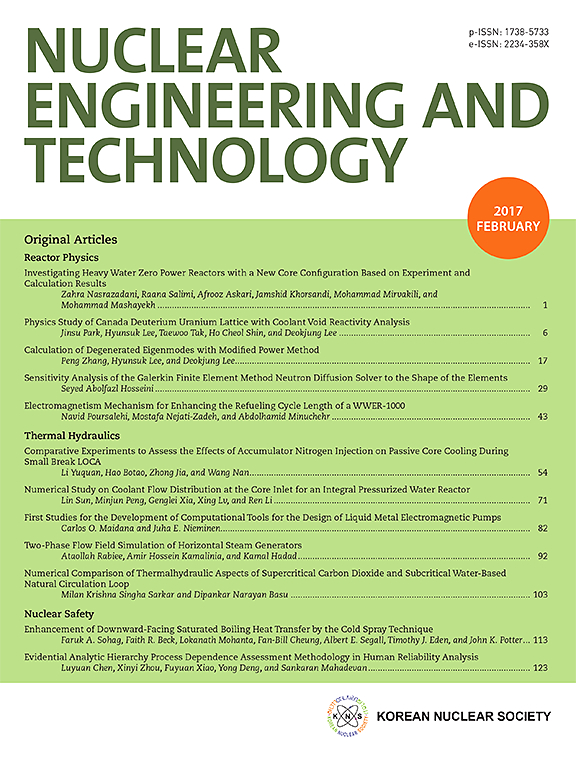Thiol unit-functionalized ultrastable two-dimensional polymer for adsorption of palladium ions in a nitric acid medium
IF 2.6
3区 工程技术
Q1 NUCLEAR SCIENCE & TECHNOLOGY
引用次数: 0
Abstract
In contrast to the conventional postsynthetic oxidation process for constructing amide linkages, a two-dimensional (2D) polymer (DPA) platform with abundant amide-linkages was directly constructed in this study via a single step using the condensation reaction of trimesyl chloride and melamine. The subsequent postfunctionalization of the as-prepared platform was performed by further reacting it with cysteamine to form thiol units around the DPA platform. Next, the amide-linked thiol unit–functionalized 2D polymer (DPA-BGA) was applied in the selective adsorption of Pd(II) in a nitric acid medium. DPA-BGA exhibited high chemical stability when immersed in 3 M nitric acid for 24 h and high selectivity for Pd(II) over other 13 types of representative metal ions coexisting in the system. Furthermore, using X-ray photoelectron spectroscopy and density functional theory analyses, a plausible adsorption mechanism that involved the interactions between the thiol unit and Pd(II) was identified. Moreover, recycling experiments were performed to demonstrate the reusability of DPA-BGA, which could be used for at least four consecutive adsorption–desorption cycles without a considerable decrease in performance. This study provides a strategy for constructing a stable amide-linked 2D polymer platform and offers a method for its versatile functionalization for application in the field of nuclear research.
巯基单元功能化超稳定二维聚合物在硝酸介质中吸附钯离子
与传统的构建酰胺键的合成后氧化工艺不同,本研究通过三甲酰氯和三聚氰胺的缩合反应,一步直接构建了具有丰富酰胺键的二维(2D)聚合物(DPA)平台。随后制备的平台的后功能化是通过进一步与半胱胺反应在DPA平台周围形成硫醇单元来完成的。接下来,将酰胺连接的硫醇单元功能化二维聚合物(DPA-BGA)应用于硝酸介质中Pd(II)的选择性吸附。DPA-BGA在3 M硝酸中浸泡24 h具有较高的化学稳定性,对Pd(II)的选择性高于体系中共存的其他13种代表性金属离子。此外,利用x射线光电子能谱和密度泛函理论分析,确定了硫醇单元与Pd(II)之间相互作用的合理吸附机制。此外,还进行了回收实验,以证明DPA-BGA的可重复使用性,该材料至少可以连续使用四次吸附-解吸循环,而不会显著降低性能。本研究为构建稳定的酰胺连接二维聚合物平台提供了一种策略,并为其在核研究领域的应用提供了一种多功能功能化方法。
本文章由计算机程序翻译,如有差异,请以英文原文为准。
求助全文
约1分钟内获得全文
求助全文
来源期刊

Nuclear Engineering and Technology
工程技术-核科学技术
CiteScore
4.80
自引率
7.40%
发文量
431
审稿时长
3.5 months
期刊介绍:
Nuclear Engineering and Technology (NET), an international journal of the Korean Nuclear Society (KNS), publishes peer-reviewed papers on original research, ideas and developments in all areas of the field of nuclear science and technology. NET bimonthly publishes original articles, reviews, and technical notes. The journal is listed in the Science Citation Index Expanded (SCIE) of Thomson Reuters.
NET covers all fields for peaceful utilization of nuclear energy and radiation as follows:
1) Reactor Physics
2) Thermal Hydraulics
3) Nuclear Safety
4) Nuclear I&C
5) Nuclear Physics, Fusion, and Laser Technology
6) Nuclear Fuel Cycle and Radioactive Waste Management
7) Nuclear Fuel and Reactor Materials
8) Radiation Application
9) Radiation Protection
10) Nuclear Structural Analysis and Plant Management & Maintenance
11) Nuclear Policy, Economics, and Human Resource Development
 求助内容:
求助内容: 应助结果提醒方式:
应助结果提醒方式:


